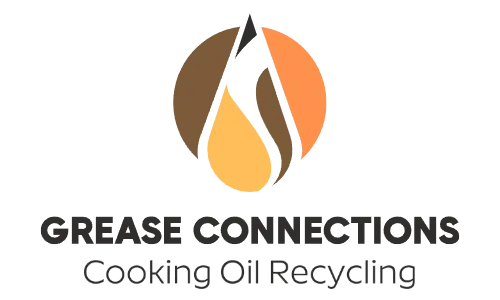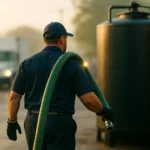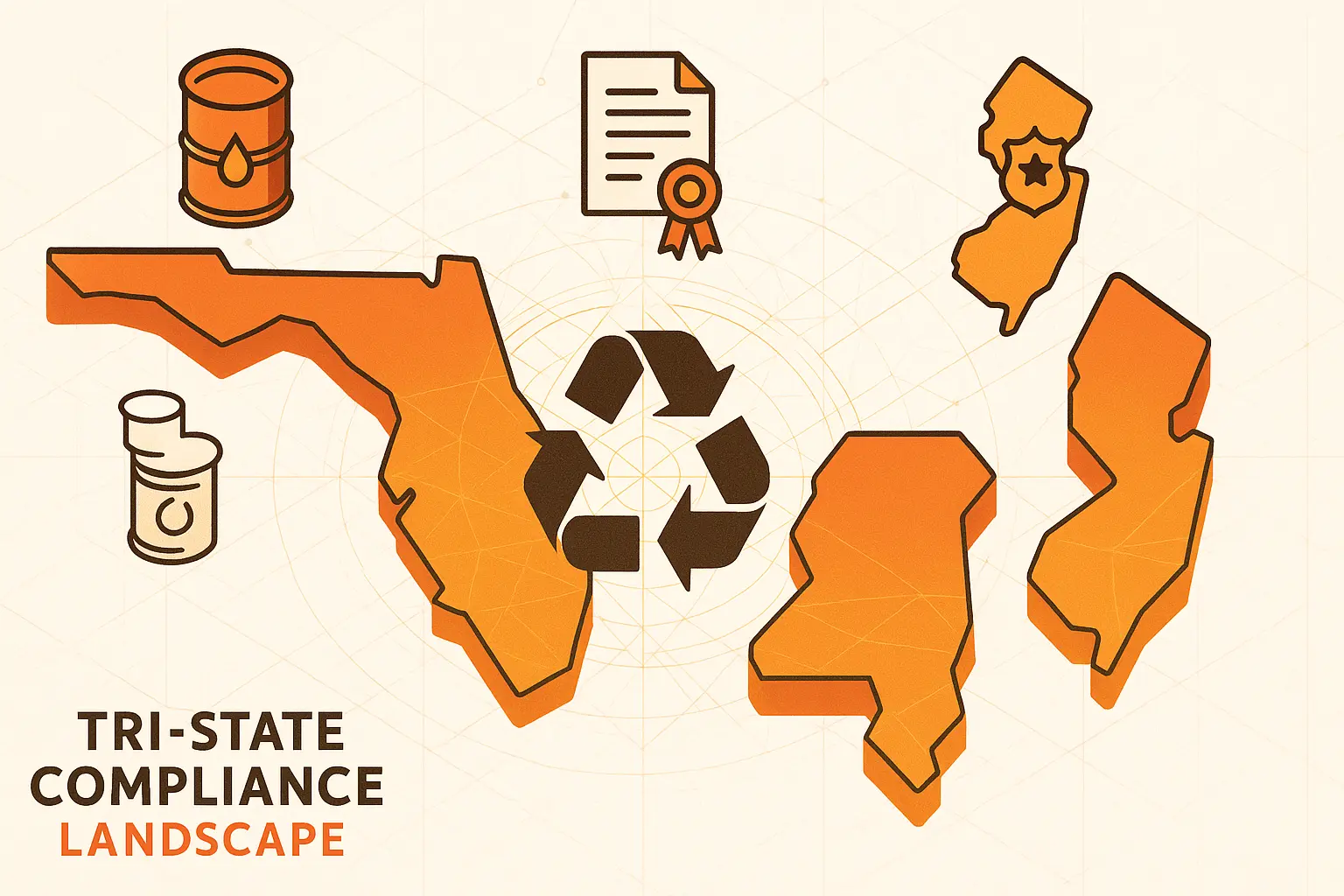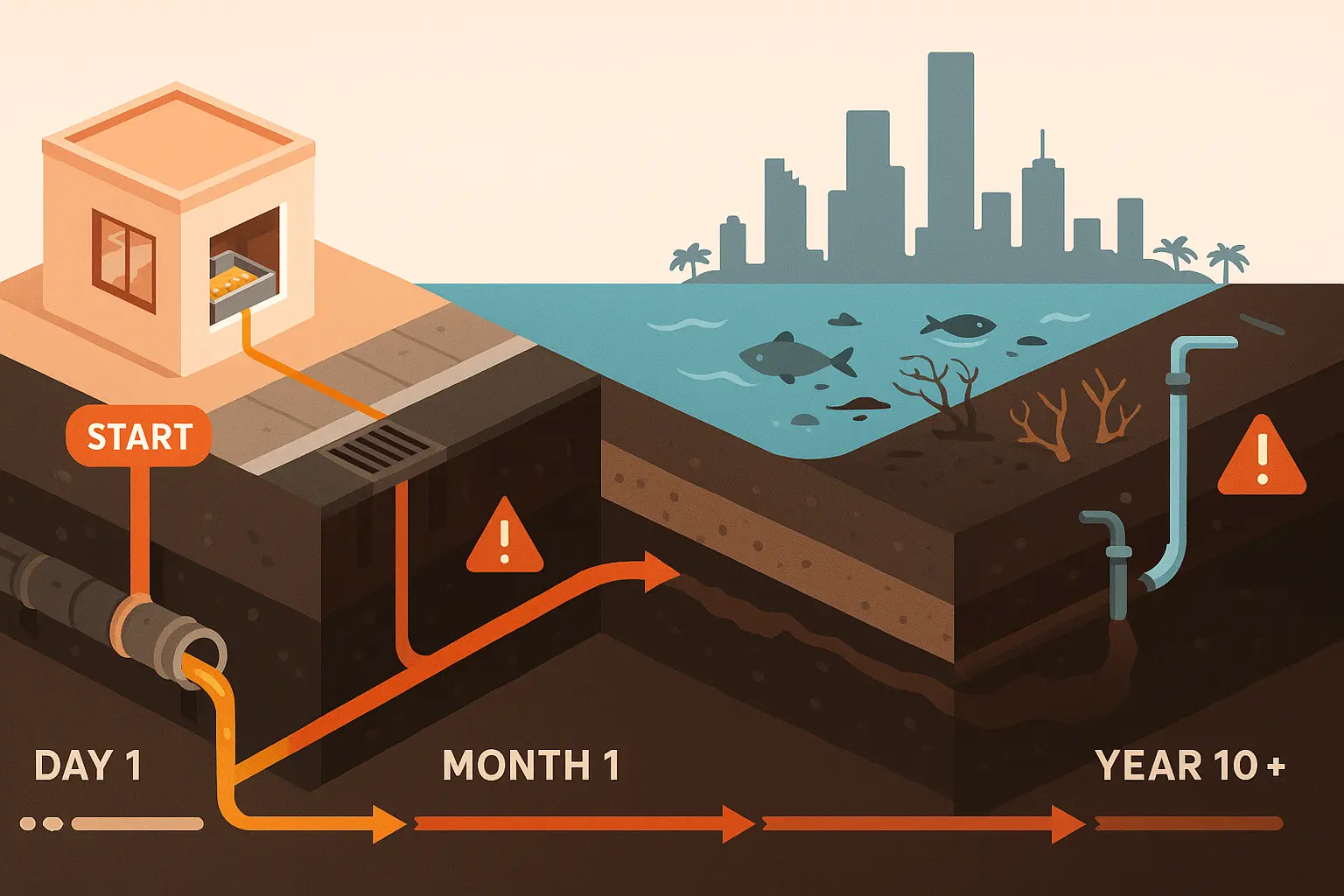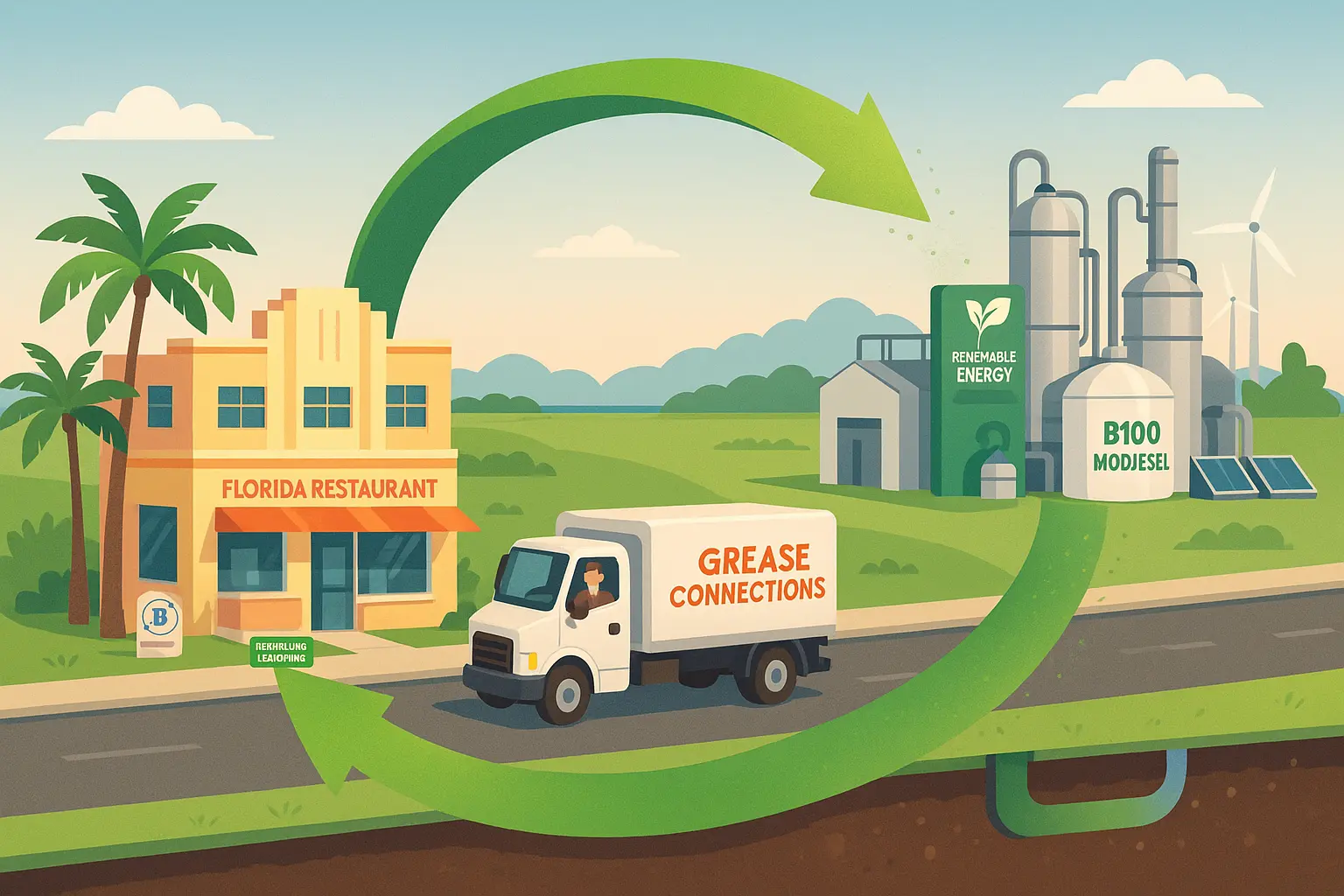Introduction
Yes — restaurants in Georgia, Florida, and New Jersey can sell grease for money in 2025. A gallon of used cooking oil is no longer mere kitchen waste; it is a tradable commodity that processors refine into yellow grease, biodiesel fuel, soap, and other industrial products. According to the Jacobsen Report’s Q1 2025 rendering-markets analysis, spot values for fryer material averaged USD 0.36 – 0.42 per lb. Grand View Research estimates the national market for restaurant lipids will reach USD 9.2 billion by 2028, up from USD 6.8 billion in 2024, underscoring durable demand.

When a professional uco company such as Grease Connections removes your used cooking oil on schedule, you avoid disposal headaches and receive dependable pay. Are you certain your kitchen is capturing every possible rebate?
How the Used Cooking Oil Market Works in 2025
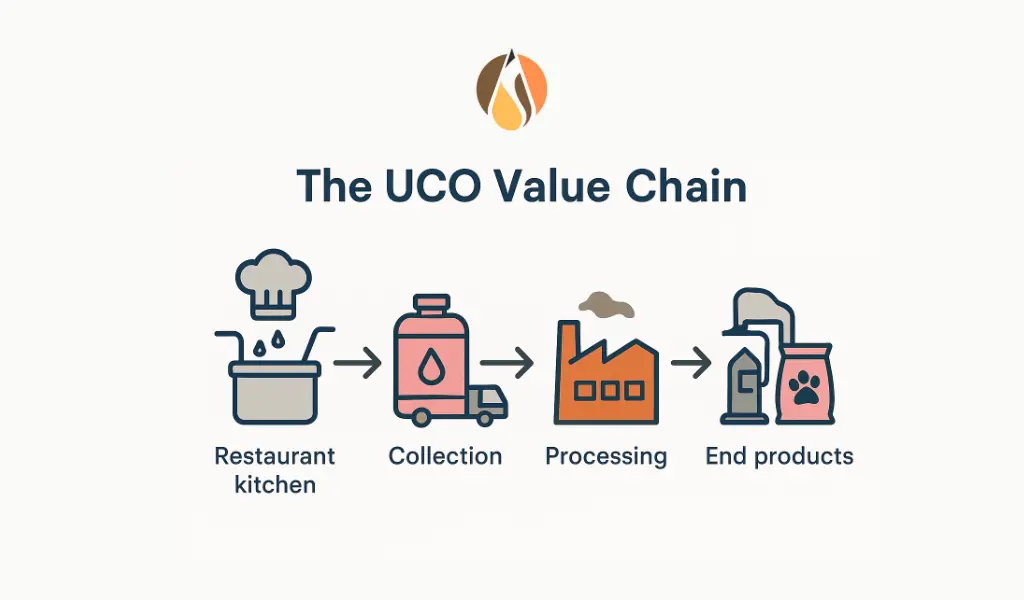
The cooking oil recycling chain starts in the kitchen and ends at a biodiesel plant, a specialty-chemical kettle, or an animal feed blender.
- Restaurants cook food, generating vegetable oil, blended oils, and fryer drippings.
- A Grease Connections truck pumps the oil into a sealed uco collection tank and issues a ticket showing your expected payment.
- Processors separate water, fat, and solids to prevent contamination.
- Clarified material becomes biodiesel production feedstock, is blended into lubricants, or hardened into bar-soap and candles.
Because motor oil, gasoline, and used motor oil still dominate the U.S. fuel mix, policy incentives reward every gallon routed into renewable energy pathways. That support flows back to kitchens as stable rebates for used cooking grease (U.S. EPA Renewable Fuel Standard, 2024 LCA update).
Regional Highlights
| Region | 2025 Market Insights |
|---|---|
| Georgia | Short hauls to coastal refiners keep freight low and prices high. |
| Florida | Cruise and tourism demand low-carbon blends; fast pickups earn top dollar. |
| New Jersey | Access to Philadelphia and Long Island processors raises bids for clean loads. |
Current Prices for Used Cooking Oil in Georgia, Florida, and New Jersey
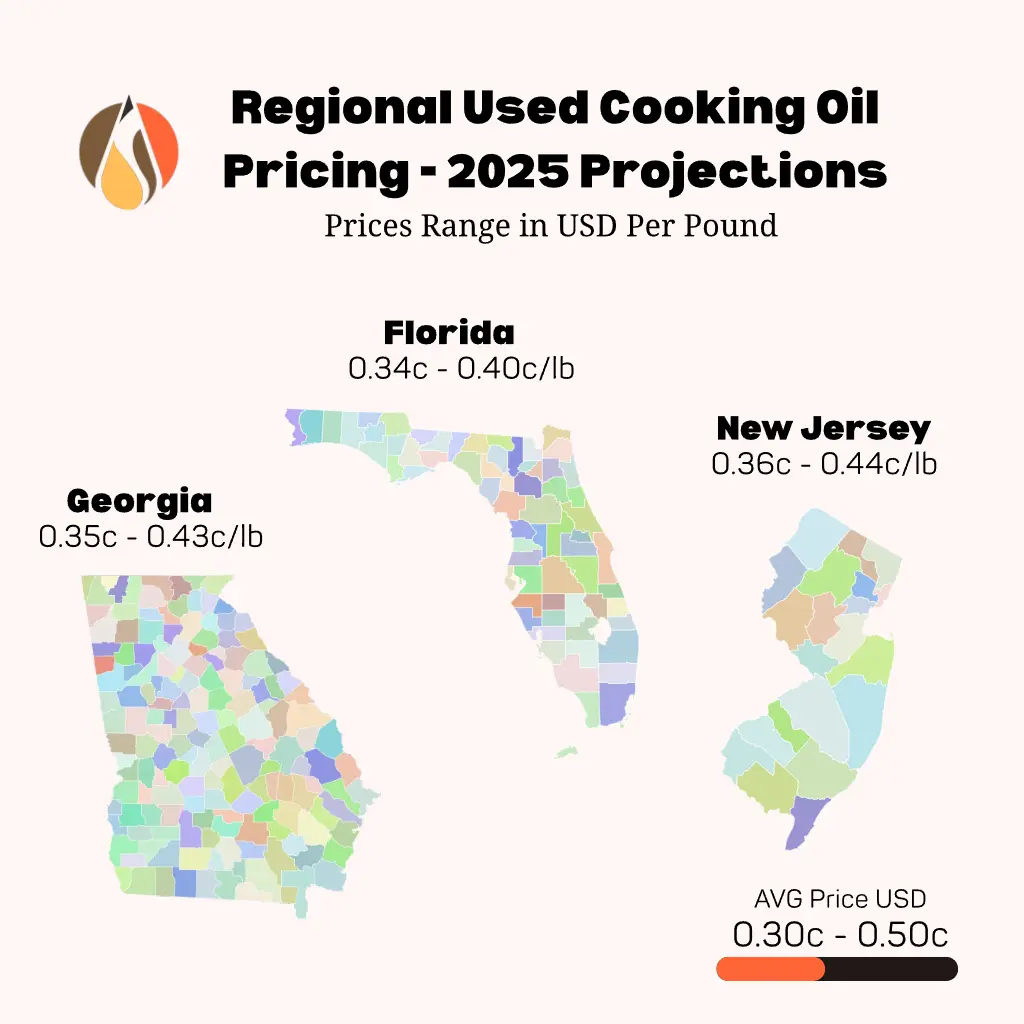
| State | Typical 2025 Prices (USD / lb) | Key Variables |
|---|---|---|
| Georgia | 0.35 – 0.43 | 48-hour pickup boosts recycled yield. |
| Florida | 0.34 – 0.40 | Humidity can add water, trimming pay. |
| New Jersey | 0.36 – 0.44 | Proximity to reiter trading terminals lifts offers. |
Real-world example: A mid-sized Atlanta restaurant running four fryers earned about $1,200 in rebates last year, while a small St. Petersburg café with two fryers received roughly $600. Could your operation be missing out on similar returns?
Seasonal Market Dynamics
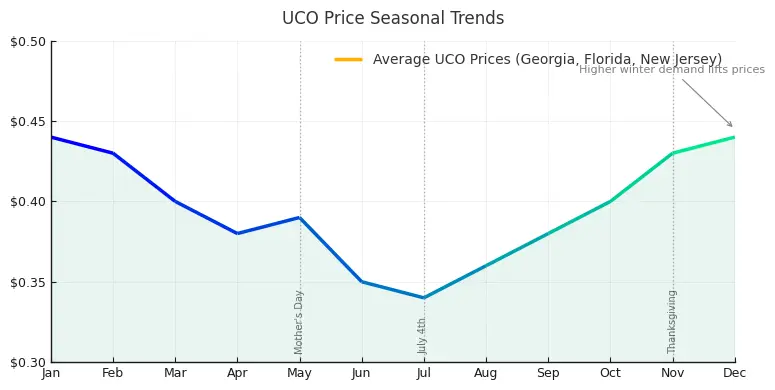
Prices typically rise 5 – 8 percent from November through January as colder temperatures thicken diesel blends and refiners buy more liquid feedstock. In humid Southern summers, water pickup can lower quality, so weekly collections are recommended for Georgia and Florida, whereas New Jersey kitchens often stretch to 10-day cycles in cooler months. Operators should keep material in shaded, sealed tanks to curb oxidation during heat waves and schedule pre-holiday pump-outs—especially before Mother’s Day, Independence Day, and year-end peaks—to capture top dollar when fryer output surges.
What Determines How Much Money Your Restaurant Gets for Grease
- Oil purity — water, other contaminants, and brown grease lower grade.
- Pickup frequency — weekly service keeps cooking oil fresh.
- Storage equipment — sealed outdoor tanks protect against rain and heat.
- Regulatory fees — fines for illegal dumping of motor oil or dump motor oil erase margins.
Clean, timely collections earn best value; a contaminated load can be deemed uco worthless. Ever wondered if fee-based haulers are walking away with material that could be generating income for you instead?
Keeping Your Grease Valuable: Practical Kitchen Tips
A busy restaurant crew can safeguard rebates with simple habits:
- Filter cooking oil each shift and discard burned food.
- Rotate cooking oils so older vegetable oil is never repeatedly burned.
- Segregate used vegetable oil from towels and paper towel debris.
- Never mix fryer drippings with motor oil.
- Empty the grease trap on time; trapped brown grease spoils cleaner streams.
- Log volumes so the uco company can collect efficiently and pass savings back as pay.
- Post “No dump motor oil” signs near sinks.
Sticking to these basics keeps water down, stops contamination, and rewards your business.
Regular pickups mean your recycled volume stays audit-ready. Routine walk-throughs keep cooking oil lines sealed, prevent contaminated spills, and encourage staff to recycle fryer baskets instead of scraping food scraps into the drain.
Because purified yellow grease also flows into animal feed, farmers track industry bulletins for prices just as refiners do. Regional uco collectors bridge both markets, ensuring you still receive pay when demand shifts. Many companies report that partnering with one trusted uco collector removes ledger clutter from multiple vendors.
Why Quality Matters to Every Buyer
Renderers grade every tote of used cooking grease or used cooking oil by moisture and debris. Clean loads earn premium pay because the oil can move straight into esterification kettles for soap, yellow grease, or ultra-low-carbon diesel. If a batch arrives contaminated, processors must rid it of other contaminants before resale.
Georgia facilities often blend lighter veg oil with tallow fat for cold-weather performance, so filtered vegetable oil stays valuable—provided it never contacts sludge from the grease trap. Partnering with regional uco collectors lets your business track solids, moisture, and expected payment in a single dashboard.
Why Choose a Specialized UCO Collector?
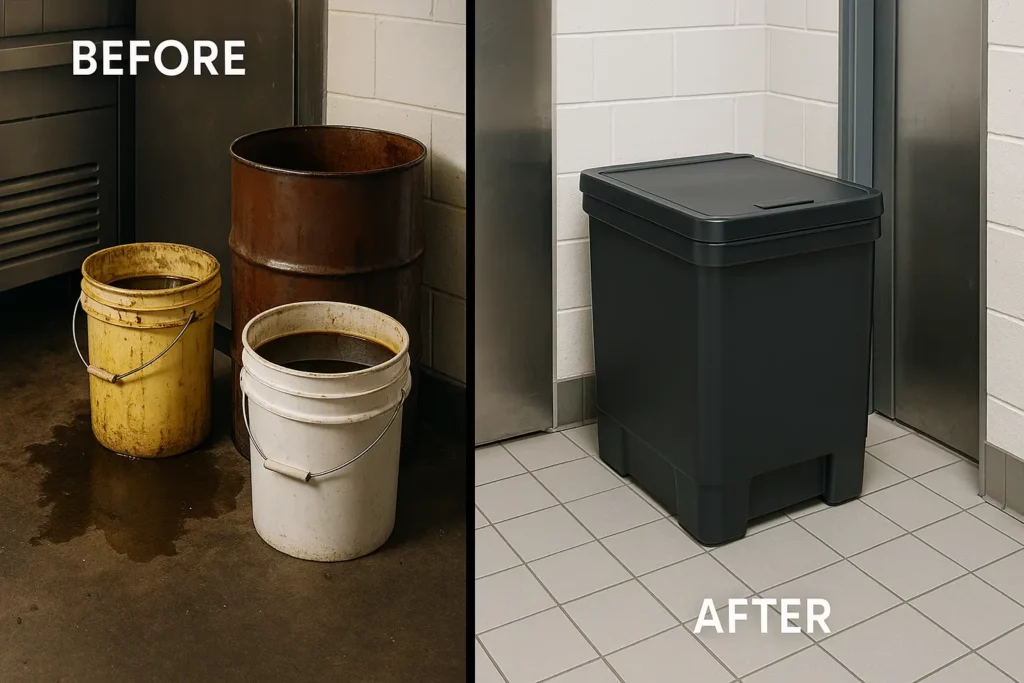
- Dedicated equipment keeps lines sterile and minimizes downtime.
- Digital volume tracking shows exactly what left your loading dock and when.
- Optimized routing means faster pickup cycles, which can raise rebate rates.
- Industry-focused teams understand compliance paperwork, simplifying audits.
General waste haulers seldom offer this level of transparency or market insight, which can translate into lower payouts for the same material.
Emerging Trends in the Used Cooking Oil Market
Analysts expect reclaimed-feedstock values to stay firm through late 2025, then edge higher in early 2026 as new renewable-diesel refineries open along the Gulf Coast and in New Jersey. The National Renderers Association projects a 4 – 7 percent uptick once those plants come online, tightening supply in the Southeast.
Smart-sensor level monitors and AI-driven route optimization are already trimming empty-truck miles by roughly 18 percent, speeding pickups and stabilizing rebate schedules. EPA’s final 2025 Clean Fuel Production Credit will also raise documentation standards for traceability, favoring kitchens that already use digital tracking. Meanwhile, researchers are testing hydrotreated lipid outputs for marine bio-lubricants and renewable asphalt binders—new, higher-value destinations for yellow grease that could support stronger rebate structures in 2026.
Benefits Beyond Direct Payment for Selling Your Grease
- Rid your site of fire hazards and odors.
- Cut plumber visits by keeping the grease trap clear.
- Lower greenhouse gas emissions by feeding the renewable energy supply chain.
- Strengthen ESG reports with traceable recycled volumes.
- Avoid hefty fines in all three states for improper disposal.
- Support domestic low-carbon fuel makers and insulate fleets from volatile gasoline prices.
Common Questions About Selling Restaurant Grease for Money
How much cash can restaurants typically make from selling used cooking oil in 2025?
Small diners average $75 – $125 per month; multi-unit groups $400 – $1,200, depending on volume and oil quality.
What factors affect payment rates for used cooking oil in the Southeast and Mid-Atlantic?
Water content, free fat acids, distance to processors, and seasonal biodiesel demand.
Can restaurants sell brown grease from grease traps for money?
Few renderers pay for brown grease; most charge haul-away fees. Focus on fryer oils instead.
How does oil quality affect payment rates in Georgia, Florida, and New Jersey?
Cleaner, recently filtered cooking oil earns top dollar; high water or particle counts trigger downgrades.
What’s the process for getting started with selling used cooking oil?
Contact a licensed used cooking collector, schedule a site assessment, install a sealed tank, and start tracking pickups.
Are there local regulations in Georgia, Florida, or New Jersey that affect collection?
Yes. The Florida Department of Environmental Protection can levy penalties up to $10,000 per violation for improper disposal. Georgia Environmental Protection Division Rule 391-3-6-.24 requires transporters to register and keep detailed manifests, with fines of $25,000 per day for non-compliance. New Jersey Department of Environmental Protection NJAC 7:26A-2.1 mandates annual “Class D” certification for transporters and written spill-containment plans at every service site.
Ultimately…
Turning fryer oil into revenue is straightforward:
- Keep cooking oil clean and free from contaminated waste products, water or solids.
- Store it in a secure, weather-tight tank.
- Partner with a reputable company that offers transparent prices, prompt pay, and certified recycling.
Follow those steps and even a single tote of used cooking oil can capture top dollar while protecting waterways, cutting landfill methane, and showing guests that sustainability can pay real dividends.
Ready to see what your kitchen could earn? Contact Grease Connections for a free used cooking oil kitchen assessment and custom quote tailored to your location in Georgia, Florida, or New Jersey.
